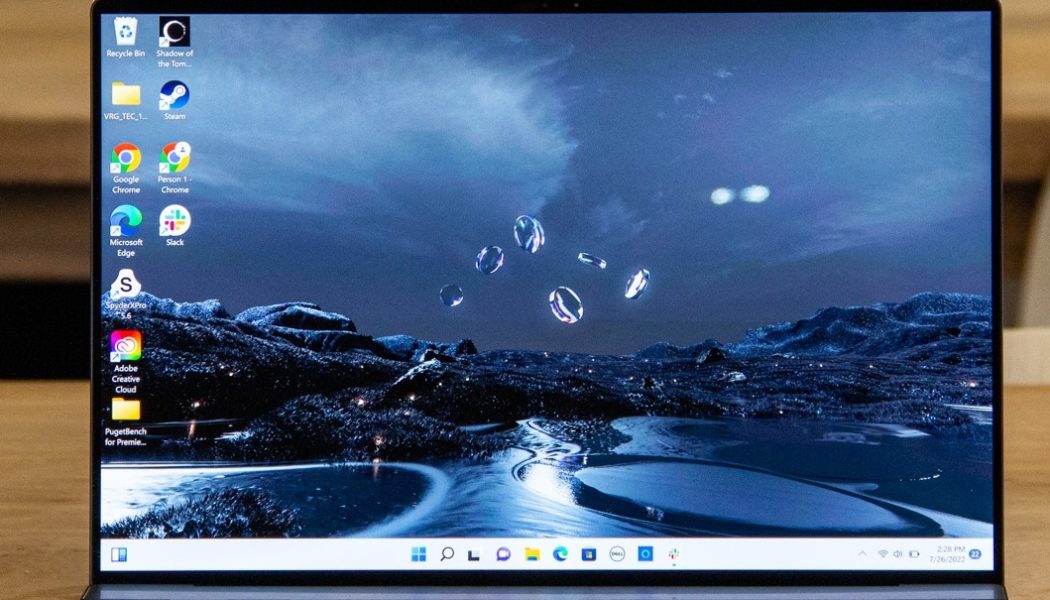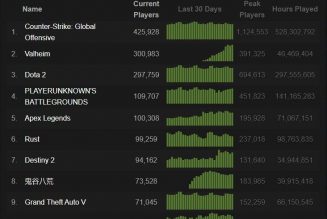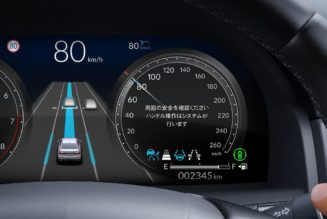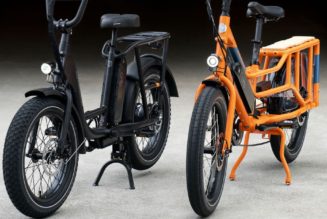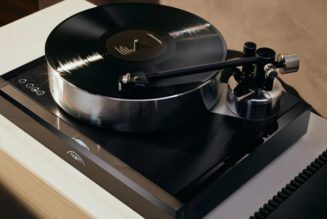Dell collectively shocked everyone who follows the laptop market when it announced the XPS 13 Plus. After I published my first impressions last December, I got all kinds of DMs and emails from people asking what the heck this thing was. It’s a laptop unlike anything ever seen — and many of us have spent the past half year wondering whether that’s a good or bad thing.
The regular XPS 13 (no Plus to be found) has long been one of our top Windows laptop recommendations. It’s a standout in many ways, build quality chief among them. Dell is continuing to sell that model and has upgraded it to 12th Gen processors. The XPS 13 Plus is a separate model and, as I understand, is for folks who want to take that XPS’s performance to the next level — anyone who wants as much raw muscle as they can get in a 13-inch machine.
To that end, Dell has pulled out every shoelace to make the XPS 13 Plus as thin as it can possibly be. The touchpad is haptic and fully integrated into the palm rest. There are barely any ports. The keyboard has been flattened and the function row replaced with a row of touchable LEDs. And the Plus starts $300 more expensive than its non-Plus counterpart. These are all compromises, Dell’s case is, in order to achieve the thinnest and most powerful laptop possible.
Unfortunately, the XPS 13 Plus is not that. It is more expensive and much hotter than laptops of its same size and weight that deliver similar or better power, significantly better battery life, better webcams, and more usable port selections — and that’s without even getting into the various finicky things with the keyboard deck. I can’t be the only one getting deja vu here. This whole situation is giving 2016 vibes when Apple made all kinds of changes to the MacBook in the name of thinness that ended up… not quite panning out.
Like that 2016 MacBook, this XPS 13 Plus is a nice-looking computer with a great screen. But even among folks who really must have the Dell branding and the Windows operating system, I don’t see it as the choice.
To begin on a positive note, the XPS 13 Plus is exquisitely crafted from aluminum and glass. The lid is as sturdy as can be. Keep it closed, and you won’t see much difference between it and the old-school XPS. Durability can sometimes fall by the wayside as devices get thinner, but Dell hasn’t compromised on that here. You won’t find a sturdier laptop in the 13-inch space. It’s also quite a nice-looking machine, with the flat keyboard deck creating a seamless aesthetic that appears decidedly futuristic. My one complaint about the chassis on my graphite color review unit is that it is a fingerprint magnet. If this is an issue for you, a platinum color is also available.
:no_upscale()/cdn.vox-cdn.com/uploads/chorus_asset/file/23904922/mchin_201020_5350_0004.jpg)
The other highlight is the display. I tested the OLED model with 3456 x 2160 resolution and a 16:10 aspect ratio. It’s a viewing delight with bright and vivid colors and very little glare. With tiny (91.9 percent screen-to-body ratio) bezels, the panel more than earns Dell’s famous “InfinityEdge” title. Note that it’s only 60Hz, which not everyone will care about but some people certainly will. (I did run into a problem on my first review unit where the screen stopped working after getting knocked off a couch onto carpet despite there being no visible external damage. Dell is sending a replacement unit, and I’ll update the article if the problem recurs on that one.)
:no_upscale()/cdn.vox-cdn.com/uploads/chorus_asset/file/23904923/mchin_201020_5350_0005.jpg)
I was also pleasantly surprised by the speaker array, which includes two upfiring tweeters beneath the keyboard and two downward-firing speakers in the base. The percussion was a bit tinny, but sound quality was otherwise great with a noticeable improvement over last year’s XPS 13 (and no distortion at max volume, which was an issue I had with the predecessor). I’d say it’s on par with the audio from the M2 MacBook Air, which is quite good for the category and far ahead of what’s typical with Windows laptops. Equalizer settings can be adjusted in the preinstalled MaxxAudio program.
:no_upscale()/cdn.vox-cdn.com/uploads/chorus_asset/file/23904927/mchin_201020_5350_0011.jpg)
But elsewhere, the sacrifices Dell has made in the name of thinness are evident. Before I get into them, I want to put this machine’s size in context. It is 0.6 inches thick and 2.77 pounds. (The non-OLED model is 2.71.) It is quite portable, sure, but there are plenty of thinner and lighter Windows laptops in the 13-inch space, including OLED options and products that are much cheaper than this one. The M2 MacBook Air is also noticeably thinner and lighter than this configuration.
First compromise: the only ports here are two Thunderbolt 4 USB-C ports. There’s not even a headphone jack. One of those USB-C is required to charge the laptop. That’s a factor here because the included 60W adapter doesn’t charge the device particularly fast. Alongside light Chrome use, my unit took an hour and 14 minutes to reach 60 percent. You should factor the price of a USB dock or hub into the price of this device.
:no_upscale()/cdn.vox-cdn.com/uploads/chorus_asset/file/23904925/mchin_201020_5350_0009.jpg)
Second: the touch bar. This isn’t actually a touch bar like Apple’s customizable (and now effectively abandoned) Touch Bar — it’s a “capacitive touch function row.” But like that touchscreen strip, it replaces the physical function row that other keyboards have. It’s a row of LEDs that include things like brightness, volume, microphone muting, escape, insert, etc. Holding down Fn on the keyboard changes the LEDs to the regular function keys.
My first issue with this, similar to many complaints about Apple’s Touch Bar, is that there’s no haptic feedback, so I’m often not entirely sure if I’ve actually pressed the key. Second, if something ever got on the row (dust, hair, whatever), I could never brush it off without pressing a bunch of buttons in the process and messing up whatever I was in the middle doing. Third, I wasn’t prepared for how disconcerting it would be for keyboard shortcuts involving things like Delete and Escape to require a mix of real keys and fake keys. Maybe this is something you get used to, but at the moment, it feels very weird.
:no_upscale()/cdn.vox-cdn.com/uploads/chorus_asset/file/23904926/mchin_201020_5350_0010.jpg)
Third: the trackpad. When you open up the XPS 13 Plus, the first thing you’ll likely notice is that there doesn’t appear to be a touchpad — there’s just a seamless strip of glass below the keyboard deck. Now, there is actually a capacitive touch trackpad in the area where you’d expect it to be; it’s just not delineated in any way, and you’re relying on muscle memory to ensure you click in the right spot.
I didn’t have trouble with daily navigation here; my right hand did instinctively know where to click. Unfortunately, my left hand hasn’t developed that muscle memory and that became a problem on occasions when I needed it to sub in. This was especially cumbersome when I needed to click and drag things or highlight text, which usually requires two hands for me. I very often missed the unseeable zone with my left hand’s first shot.
Separately, the trackpad’s click feels shallow. Dell actually encouraged reviewers to have their families test the device. (They wouldn’t believe it was a solid piece of glass, we were told.) So I had my mother give it a click. “It feels weird,” she remarked. I explained that it was a haptic touchpad. “Oh, that makes sense,” she said.
I also gave the unit to my younger brother, telling him it was haptic beforehand. “Aren’t Apple’s like that?” he asked. I confirmed that they were. “The Apple one’s better,” he said as he clicked around with the XPS. Guess it depends on the family.
Last thing with the trackpad — it went haywire when my hands were even slightly wet, often thinking it was depressed when I wasn’t depressing it (which made it basically unusable). I asked Dell about this, and they said that this is a common occurrence with all capacitive trackpads (which includes most modern trackpads) and recommended that I dry my hands before using the laptop. Fair enough, but I use multiple laptop models every week and rarely, if ever, experience issues to this degree.
:no_upscale()/cdn.vox-cdn.com/uploads/chorus_asset/file/23904930/mchin_201020_5350_0015.jpg)
I don’t have as much of a problem with the new “zero-lattice” keyboard, which has been completely flattened. It’s literally edge to edge now, with almost no space between the keys. If pictures make you worry that we’ve got the second coming of the butterfly keyboard on our hands, don’t worry — it’s not quite that bad. There’s only 1mm of travel, but the keys actually feel quite bouncy while staying fairly quiet. The caps are wide enough that I had no problem typing quickly and accurately, though the overall feel took some getting used to. There are a couple finicky layout things that will bother some people: the arrow keys are half-height, and the power button is squeezed in next to the backspace key.
:no_upscale()/cdn.vox-cdn.com/uploads/chorus_asset/file/23904924/mchin_201020_5350_0008.jpg)
Finally, the webcam is an improvement over last generation (which is a low bar) but still not amazing. Rather than go the Apple route and have a camera notch stick out of an otherwise tiny bezel, Dell has kept that tiny bezel but separated the infrared camera (for facial recognition) out from the regular 720p webcam. My co-workers were able to see details like strands of hair while I was on video calls, and I wasn’t dark or washed out, but the image was still fairly grainy and noisy.
:no_upscale()/cdn.vox-cdn.com/uploads/chorus_asset/file/23904929/mchin_201020_5350_0014.jpg)
Underlying all of this is the biggest promise of the XPS 13 Plus: the 12th Gen Core P-Series chip. Most laptops of this size use the U-Series, which is designed for the thin and light form factor, but the Plus isn’t messing around with those. The $1,299 base model includes an i5-1240P, 8GB of RAM, 512GB of storage (an M.2 Gen 4 PCIe SSD), and a 1920 x 1200 non-touch display. The unit I was sent is significantly swankier, with a Core i7-1280P, 16GB of RAM, 512GB of storage, and the higher-resolution OLED screen. That unit with a non-OLED 1920 x 1200 screen is $1,749. The SSD is upgradeable, but everything else is soldered.
This model costs $1,949 — which, needless to say, makes this an expensive computer. An M2 MacBook Air (again, thinner and lighter, with more ports, a better webcam, a physical function row, and a more usable trackpad) with comparable specs could be as much as $350 cheaper than the model I have — the model we reviewed with a 10-core CPU is $250 cheaper. (Both are cheaper than XPS Plus’s non-OLED non-touch model). A Core-i7, U-series XPS 13 (which only comes with a 1920 x 1200 display) would be $600 cheaper.
When it comes to performance, this device is certainly an improvement over the 11th Gen XPS 13, and it’s certainly more powerful than any 12th Gen U-Series machine you can buy. I didn’t experience any performance issues in most of my office work, and photo editing was fine. Premiere Pro was not at all fun — multiple versions of the program took forever to open and were slow to run, freezing every so often — but that’s not uncommon in this segment of the market.
In benchmark testing, the 13 Plus is beating Apple’s M2 MacBook Air in multicore benchmark tests. However, it is not approaching the M2 in the single-core or graphic use cases we ran. The other distinct advantage the XPS 13 Plus has over the Air is its fan, which will theoretically help it better sustain long-term loads. But the XPS 13 Plus’ fan was really struggling here, because, boy oh boy, did this thing get hot.
After a few hours of regular use (which, in my case, is a dozen or so Chrome tabs with Slack running over top), this laptop was boiling. I was getting uncomfortable keeping my hands on the palm rests and typing on the keyboard. Putting it on my lap was off the table.
I usually work in Quiet mode, but I tried all the various fan profiles and nothing made a great deal of difference. In Optimized, the chassis was a bit cooler but still toasty. The Cool mode certainly made the fans annoyingly loud but didn’t really make the chassis comfortably cold. I used Ultra Performance during benchmark testing (which made the fans loud loud, like Intel MacBook Pro levels of loud), and the CPU was still frequently hitting (and sometimes hanging out around) 100 degrees Celsius. Despite its impressive power, this device still seems to make the most sense for short-term activities if you don’t want to fry your chassis and CPU — and decreasing scores in back-to-back Cinebench runs back me up on that.
Dell XPS 13 Plus benchmarks
| Benchmark | Score |
|---|---|
| Benchmark | Score |
| Geekbench 5.3 CPU Single | 1665 |
| Geekbench 5.3 CPU Multi | 10708 |
| Geekbench 5.3 Open CL / Compute | 20483 |
| Cinebench R23 Single | 1404 |
| Cinebench R23 Multi | 8817 |
| Cinebench R23 Multi 30 min loop | 8509 |
| PugetBench for Premiere Pro | 393 |
| Shadow of the Tomb Raider (1920 x 1200, highest) | 19fps |
| 4K Export (Adobe Premiere Pro 15) | 6:54 |
And then there’s the battery life. I was only averaging five hours and two minutes of continuous use with the screen around 200 nits. The high-resolution screen is no doubt a factor here, as we often see disappointing longevity from OLED XPS models (although OLED technology should, theoretically, be helping with battery life). Still, I always review the configuration I have, and this one did not last long enough to justify a $2,000 price point.
This exacerbates the connectivity problem, because this thing is going to need to spend a lot of time plugged in — so you’re really kissing 50 percent of your port selection goodbye. I know I sound like a broken record here, but I just want to emphasize — the MacBook Air lasts me over twice as long.
The XPS 13 Plus is impressive in its willingness to challenge the status quo. You don’t often see a laptop that’s trying to do what very few products have achieved. I respect Dell’s goal of putting a P-series processor in such a thin and beautiful chassis.
But all the innovation in the world hasn’t changed what this laptop fundamentally is. It’s an OLED XPS. And I’m ultimately telling the same story here that I’ve been telling about OLED XPS models for years on end. It’s beautiful, it’s powerful, but it’s too hot, and the high-resolution screen is murdering the battery life.
I still use a 2019 MacBook Pro for work, and I’m surprised how similar using the XPS 13 Plus feels to that experience. Like that MacBook, the Plus is thin and light — but it’s also always hot, starved for ports, and doesn’t have a practical battery lifespan. Apple made those unpopular changes in the name of thinness, and it’s perhaps telling that it’s decided to reverse many of them in the past few years. Dell’s changes have been less extreme in some areas (the keyboard) and more extreme in others (the ports), but I worry that the overall narrative is trending in the same direction.
I haven’t reviewed the regular XPS 13 yet, but my sense is that Dell intends for that to remain most people’s option, and for the Plus to be the “power user” laptop. But with its limited connectivity and questionable capacity to hold its own under “power user” loads, I’d hesitate to recommend this model to that group. I suspect that folks who need the full power of a Core i7-1280P may want something with USB-A, at the very least.
Photography by Monica Chin / The Verge
